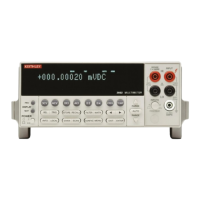Front Panel Operation
2-104
AUTOZERO: In order to maintain stability and accuracy
over time and temperature, the Model 2002 intermittently
measures internal voltages corresponding to offsets and
gains of amplifiers. This process is known as autozeroing.
There are three types of autozero: synchronous, normal, and
off. The characteristics of each are described below.
• Synchronous (the default mode) is the most accurate,
but slowest mode. In this mode, each trigger causes
three A/D conversions: one for input signal, one for an
internal zero, and one for an internal gain. This mode
also yields a constant reading rate.
• Normal is slightly less stable than synchronous, but
significantly faster. In this mode, internal measurements
are only taken often enough to maintain specified accu-
racy. Because internal readings are not consistently tak-
en, the reading rate is higher, but not constant.
• Off disables the autozeroing mechanism. This mode
yields the fastest reading rate at the expense of
decreased reading stability.
With this selection, the type of autozero is chosen. Changing
autozero halts triggers and puts the instrument into the idle
state. Use the TRIG key to re-arm triggers. In addition, enter-
ing the burst data acquisition mode disables autozero.
NOTE
With autozero disabled, calibration accu-
racy will drift with time and temperature.
It is recommended that an autozero refresh
be performed every 24 hours to ensure
measurement integrity. This can be per-
formed by enabling and then disabling
autozero, by changing speed or function,
or by issuing an autozero bus command.
The burst data acquisition mode disables autozero. This type
of measurement requires an autozero refresh once every 24
hours by performing one of the following:
• Change the display resolution.
• Change the measurement function.
The options for AUTOZERO are as follows:
• DISABLE — Disables autozero.
• NORMAL — Enables normal autozero.
• SYNCHRONOUS — Enables synchronous autozero.
Changing autozero halts triggers and puts the instrument into
the idle state. Use the TRIG key to re-arm triggers.
TIMESTAMP
A timestamp is available for readings sent over the bus and
for readings stored in the buffer. This GENERAL menu
selection is used to configure the timestamp for readings sent
over the IEEE-488 bus. From the front panel, readings are
sent over the bus via the GPIB selection of the MAIN MENU
(see paragraph 2.12.2). See paragraph 2.8.2 to configure the
timestamp for buffer readings.
Specifically, this selection is used to perform the following
operations:
• Select the type of timestamp; relative or real-time.
• Reset the relative timestamp to zero.
• Reset the reading number to zero.
Timestamp and the reading number are only included with
each reading if they are selected as GPIB data elements (see
paragraph 2.12.2). Figure 3-18 shows how the timestamp
and reading number is included with each reading.
The menu items for TIMESTAMP are explained as follows:
TYPE: This item is used to check or change timestamp type.
Note that changing the timestamp type clears the buffer. The
two timestamp types are described as follows:
• RELATIVE TIME — With this selection, timestamps
are oriented to a timer and references each reading to a
point in time. The timer starts at 0.000000 seconds
when the instrument is turned on or when the relative
timestamp is reset (see RESET-TIME). After
99,999.999999 seconds, the timer resets to zero seconds
and starts over.
• REAL-TIME — With this selection, timestamps are
oriented to the real-time clock and provide the current
time (24-hour format) and date for each reading.
Power Line
Frequency
0
1
2 3 PLC
A/D
Conversion
#1 starts
A/D
Conversion
#2 starts
A/D
Conversion
#3 starts
Note: A/D conversions assume an integration
time of ≤ 1 PLC (Power Line Cycle)
Trigger #1
occurs in
this region
Trigger #2
occurs in
this region
Trigger #3
occurs in
this region
1
Figure 2-39
Line cycle synchronization

